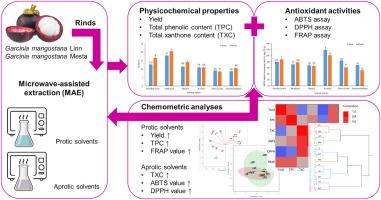Microwave-assisted extraction of Garcinia × mangostana L. and its ‘Mesta’ cultivar rinds: Physicochemical and antioxidant properties analyzed using multiple chemometric algorithms
引用次数: 0
Abstract
Mangosteen rind is an underutilized by-product rich in bioactive compounds. This study assessed the effect of microwave-assisted extraction (MAE) using different protic and aprotic solvents on the rinds of common mangosteen (Garcinia × mangostana L.) and its cultivar, Garcinia × mangostana L. ‘Mesta’. Extracts were determined for yield (8.71–20.84 %), total phenolic content (TPC) (41.04–116.35 mg GAE/g), and total xanthone content (TXC) (5.14–76.13 mg ME/g). Aprotic solvents, particularly acetone, were effective in extracting TXC (57.75–76.13 mg ME/g), which corresponded to higher antioxidant activities (ABTS: 101.27–119.17 mg TE/g; DPPH: 639.68–649.54 mg TE/g). Conversely, distilled water yielded the highest TPC, corresponding with superior FRAP values (450.77–513.23 mg Fe(II)/g). These findings highlight the critical role of solvent polarity in determining extraction efficiency and antioxidant potential. Furthermore, both unsupervised and supervised chemometric analyses (PCA, HCA, and PLS-DA) revealed solvent-dependent clustering patterns in the physicochemical and bioactivity profiles. Acetone extracts were associated with high TXC and radical scavenging activity, whereas water extracts correlated with elevated TPC and FRAP values. PLS-DA further determined key variables for extract differentiation. Overall, six extracts (LT, LM, LH, LA, MD, and LY) were determined as promising candidates for functional food and nutraceutical development due to their enriched bioactive profiles.

微波辅助提取山竹果及其“Mesta”栽培果皮的理化及抗氧化特性分析
山竹果皮是一种未充分利用的副产品,富含生物活性化合物。研究了不同质子溶剂和非质子溶剂微波辅助提取对山竹及其栽培品种山竹果皮的影响。测定提取液的收率(8.71 ~ 20.84%)、总酚含量(41.04 ~ 116.35 mg GAE/g)和总山酮含量(TXC) (5.14 ~ 76.13 mg ME/g)。非质子溶剂(尤其是丙酮)对TXC (57.75 ~ 76.13 mg ME/g)的提取效果较好,具有较高的抗氧化活性(ABTS: 101.27 ~ 119.17 mg TE/g; DPPH: 639.68 ~ 649.54 mg TE/g)。相反,蒸馏水的TPC最高,相应的FRAP值更高(450.77 ~ 513.23 mg Fe(II)/g)。这些发现突出了溶剂极性在决定萃取效率和抗氧化潜力方面的关键作用。此外,无监督和有监督的化学计量分析(PCA, HCA和PLS-DA)揭示了物理化学和生物活性谱中溶剂依赖的聚类模式。丙酮提取物具有较高的TXC和自由基清除活性,而水提取物具有较高的TPC和FRAP值。PLS-DA进一步确定了提取物鉴别的关键变量。总的来说,六种提取物(LT, LM, LH, LA, MD和LY)由于其丰富的生物活性特征而被确定为功能食品和营养保健开发的有希望的候选者。
本文章由计算机程序翻译,如有差异,请以英文原文为准。
求助全文
约1分钟内获得全文
求助全文
来源期刊

Food chemistry advances
Analytical Chemistry, Organic Chemistry, Chemistry (General), Molecular Biology
CiteScore
1.90
自引率
0.00%
发文量
0
审稿时长
99 days
 求助内容:
求助内容: 应助结果提醒方式:
应助结果提醒方式:


